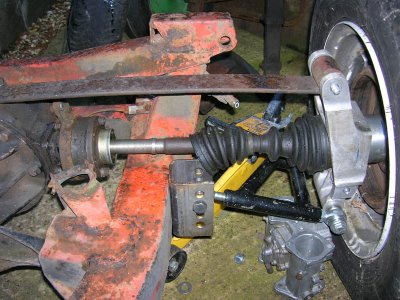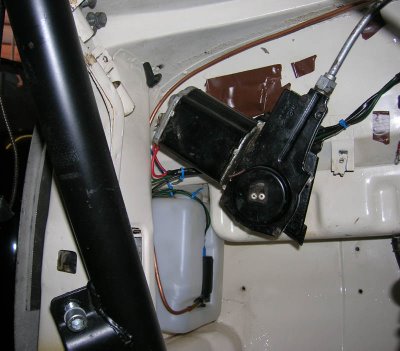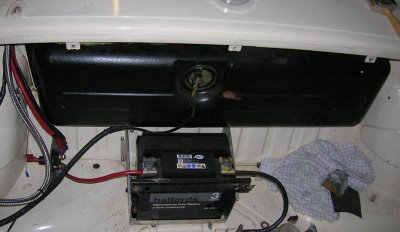Just messing about before taking the uprights for machining. I don't think I will fit the suspension for a while even if its all ready...I only just rebuilt a set of rear shafts! The car had a complete suspension overhaul about 500miles ago and felt lovely and tight, no slack anywhere! Move the wheel 2mm the road wheel moves...
I don't think I will fit the suspension for a while even if its all ready...I only just rebuilt a set of rear shafts! The car had a complete suspension overhaul about 500miles ago and felt lovely and tight, no slack anywhere! Move the wheel 2mm the road wheel moves...
Knackered Dell'Orto's have all sorts of uses.
 The wiper motor is inside the cockpit and over the passenger side, moves a bit of weight over there huh? Easy job, just take it apart and refit it the other way round...The wheel boxes work either way, bolt the tube onto the other wheel box ,rotate the motor to it its natural home on the bulhead - which it will dicate itself as its pivoting from the wheelbox. Mark the holes drill the them, bolt it on, job done.
The wiper motor is inside the cockpit and over the passenger side, moves a bit of weight over there huh? Easy job, just take it apart and refit it the other way round...The wheel boxes work either way, bolt the tube onto the other wheel box ,rotate the motor to it its natural home on the bulhead - which it will dicate itself as its pivoting from the wheelbox. Mark the holes drill the them, bolt it on, job done.
Also there's a washer bottle in this side, may go in the boot but that means more pipe and longer wires = heavy....need to ditch the brass tube, that was a midnight before MOT addition!
 Must ponder a different tank eventually...can't remember how heavy they are?! I will need atleast 6-7 gallons on occasions me thinks cause its not a pure race car is it. Battery may then have to go in the tank area, pain as i made a nice alloy box for it..., I'd like the fuel as far over the back as possible and as low as possible and slightly to the passenger side, could be a good time to hack out the bootfloor and sink a tank underneath a bi, maybe bit dangerous if you get rear ended!...away from the exhaust a bit too! to add balance via ballast...?
Must ponder a different tank eventually...can't remember how heavy they are?! I will need atleast 6-7 gallons on occasions me thinks cause its not a pure race car is it. Battery may then have to go in the tank area, pain as i made a nice alloy box for it..., I'd like the fuel as far over the back as possible and as low as possible and slightly to the passenger side, could be a good time to hack out the bootfloor and sink a tank underneath a bi, maybe bit dangerous if you get rear ended!...away from the exhaust a bit too! to add balance via ballast...?
In the dry atleast I always prefer my cars to have a good sharp nose, ie hunting apex after turn in, a bit LOWER polar momentum that we have in the normal spitfire I think....Spitfire has a very high polar moment due to its 40/60 weight spilt and frontal C of G , so it dives and understeers a bit, low PM is great and case in point is developement as seen in the 60's mid engined F1 cars - just as much use in a spitfire!... raw chassis balance maybe better with a full tank of juice and a tank further back, and to the passenger side ....but it'll increase the polar mass at the rear...not sure it thats good?! so giving the rear some more mass to rotate with, limting understeer yet further?...but not lowering polar momentum....think of the car having two ends, front and back.
The car will always turn (change direction) about its center of gravity when in a corner so the further away the centers of weight concentration are located from the center of gravity -which is their common center-, the bigger the "moment". Longer it takes to turn the mass, slower you corner and change line, direction everything.
Maybe chassis development and "balance" were what ruined motorsport!
The Lotus 49 F1 car was an amazing car in its day with a very low polar moment, in an era of mid engined F1 cars with V12's in the back and heavy complex engineering, large rear weight bias very backwards centre of gravity, hard to turn and all understeer, driven best on the power, slow in fast out!! large polar moment.
Great to reduce this polar momentum if the car is mid or anything engined, the spitfire needs all the help it can get to LOWER its moment around the front wheels and into less nosey C/G - to reduce understeer after turn in and quicken the speed at which it will change line during turn in, and then hop onto and stay onto its best traction circle.
Basically weight distribution, when its nearest to 50/50 its probably best but thats C of G not polar mass...Those mid engined beasts were 60/40 Rear biased and C/G well back.
Chapman got the first real light V8, the DFV made it part of the chassis and body stuck it right on the drivers backbone and moved him forwards a bit to the norm, hung the rear end from the engine, suspension everything - saved loads of weight at the back and improved the weight dist/polar moment to the best ever seen in the 3litre period up to 1967 by some margin.
The car was very quick and a little "unstable" ie on the nose and the back, real balance, controlled unstability...You could just tickle it into a line change as it used less slip angle... the slip angle wasnt dictating your line as with Ferrari and AAR via a constantly sliding traction circle....Lotus car used less constant slip so was always ready to react.... in an era of big unbalances and progressive understeer and oversteer depending on fuel level and weight movements, this new perfect squirrely balance led the way, ultimately making more use of the overall traction circle with less slip angle....
Tyres developed due to this, your classic CR65 Dunlop for 1967 was made to yeild max grip at 10degrees of slip angle cause the cars were that way the year before...Only in 1968 did the 49 really show its cards when it got less slippy tyres (firestones)....chassis balance increased and tyre technology changed as an intermingled equation, the ammount of slip built into the tyres was reduced year on year. Flamboyance was a dying art.
Cars for drivers like Button to shine in were the future, a that chassis that will work for you, not against you...Of course if you stuck a driver like Peterson or Rindt in one, drivers who drove purely with flamboyant talent a gift from god, they'd just hang it out anyway...Probably struggle with tyres later in a race.
Put Stewart or Lauda in one it was never seen out of shape as the super low polar moment cars like the 1973- Short wheel base Tyrells were at their best being guided rather than "driven", this is what balance is all about, often the smoother driver in this period was seen mustering faster laps than the drifters of old (who used to be MUCH faster to about 1961) these intelligent precise drivers could now do laps of great speed without looking fast! The cars began to outsmart pure talent / car control ...The chassis's no longer needed a test pilot but airline pilot with supreme racecraft.
Look at Schumacher when its all right, he barely moves the wheel, he's guiding, sensing feeling but never exceeding the limit, he has the talent to to be aggressive but he has no need cause the car needs a loving gentle tease, not a rockapes grasps...
Chassis balance, Aero balance the modern F1 is godlike.
Cars that the 1940-1950's racers like Nuvolari, Fangio would have been able to drive perfectly well and good, but they'd not be half as far ahead as when the laptimes were purely dictated by how much angle you can drift through the corners at to get past MASSIVE understeer, running plenty of rear brake bias on fast tracks and trailbraking you could do your best to rotate the car during turnin and slap the power down and ride it out...trailbraking divided the good from the god, how much you can make a terrible handling beast, with no brakes go fast....
These guys would have been lost talent in later years....They were regularly redefining the laws of psyhics in a 400hp car on 165 tyres, or atleast what the others in the paddock though was the limit.... Now the limit is your machine, Nuvoluri would regularly kick the German Auto Unions's, Ferrari works teams bums with talent alone, driving privately entered cars that were often last years machinary! Junk to the Germans silver machines.
Great times I think.
So the more you sort the car out the less fun you have drifting and battling it about, being flamboyant, but the better it is, the less work it is, and the faster you can go?! Funny old world.
I hope my car is quite boringly effective.

Took a while to cut these out! Gelcoat chipped with the Jigsaw, filler and rubbing down, musta been 4hrs work!
Bye Bye Big crank 1300.


No comments:
Post a Comment